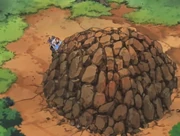No edit summary |
Omnibender (talk | contribs) (how?) Tag: sourceedit |
||
| (44 intermediate revisions by 29 users not shown) | |||
| Line 1: | Line 1: | ||
{{Infobox/Jutsu |
{{Infobox/Jutsu |
||
| − | |ref |
+ | |ref=<ref>Second Databook, page 262</ref> |
| − | |image |
+ | |image=Earth Prison Dome.png;The technique being used. |
| − | + | Earth Prison Dome of Magnificent Nothingness's Weaknes.PNG;The technique's structure. |
|
| − | |kanji |
+ | |kanji=土遁結界・土牢堂無 |
| + | |unnamed jutsu=No |
||
| − | |romaji |
+ | |romaji=Doton Kekkai: Dorō Dōmu |
| − | |literal english = |
||
| + | |literal english=Earth Release Barrier: Earth Prison of Magnificent Nothingness |
||
| − | |viz manga = |
||
| − | |english tv |
+ | |english tv=Earth Style Barrier: Earth Dome Prison |
| ⚫ | |||
| − | |other names = |
||
| − | |jutsu classification |
+ | |jutsu classification=Ninjutsu, Chakra Absorption Techniques, Barrier Ninjutsu |
| − | |jutsu type |
+ | |jutsu type=Earth Release, |
| + | |jutsu class type=Offensive, Supplementary |
||
| ⚫ | |||
| − | |jutsu |
+ | |jutsu range=Short, Mid |
| + | |users=Jirōbō, |
||
| − | |jutsu range = Short, Mid |
||
| + | |hand signs=Slam hands on ground |
||
| − | |parent jutsu = |
||
| + | |debut manga=186 |
||
| − | |related jutsu = |
||
| + | |debut anime=112 |
||
| − | |users = Jirobo |
||
| + | |debut shippuden=No |
||
| + | |game debut=Naruto: Ultimate Ninja 3 |
||
| + | |jutsu media=Anime, Manga, Game |
||
}} |
}} |
||
| ⚫ | This technique traps the victims inside a self-repairing dome of earth which is almost instantaneously able to reform, even after [[Kiba]] hit it with his [[Passing Fang]]. Jirōbō was able to absorb the chakra of anyone trapped inside, something he enjoyed greatly. However, Jirōbō's chakra was not evenly distributed throughout the dome. Near the back, relative to him, his chakra was much weaker, making the dome weaker in that spot. |
||
| + | == Trivia == |
||
| − | * '''Debut (Anime):''' ''Naruto'' Episode 112 |
||
| ⚫ | * The name of this technique shows a clever use of language. {{translation|Dorō|土牢}} means "Earth Prison." However, the usual pronunciation of these kanji is "tsuchirō," meaning "dungeon." Likewise, {{translation|dōmu|堂無}} is written with the kanji for "Magnificent Nothingness," but, when written in katakana (ドーム), it means "dome." |
||
| − | * '''Debut (Manga):''' Chapter 186 |
||
| + | == See Also == |
||
| ⚫ | This |
||
| + | * [[Ice Release: Ice Rock Dome of Magnificent Nothingness]] |
||
| − | == |
+ | == References == |
| ⚫ | The name of this technique shows a clever use of language. {{translation|Dorō|土牢}} means "Earth Prison |
||
| − | |||
| − | ==References== |
||
<references/> |
<references/> |
||
| + | [[es:Elemento Tierra: Domo Barrera de Tierra]] |
||
| − | [[Category:Jutsu]] |
||
Revision as of 22:22, 15 January 2016
This technique traps the victims inside a self-repairing dome of earth which is almost instantaneously able to reform, even after Kiba hit it with his Passing Fang. Jirōbō was able to absorb the chakra of anyone trapped inside, something he enjoyed greatly. However, Jirōbō's chakra was not evenly distributed throughout the dome. Near the back, relative to him, his chakra was much weaker, making the dome weaker in that spot.
Trivia
- The name of this technique shows a clever use of language. Dorō (土牢) means "Earth Prison." However, the usual pronunciation of these kanji is "tsuchirō," meaning "dungeon." Likewise, dōmu (堂無) is written with the kanji for "Magnificent Nothingness," but, when written in katakana (ドーム), it means "dome."
See Also
References
- ↑ Second Databook, page 262


